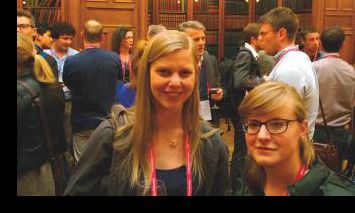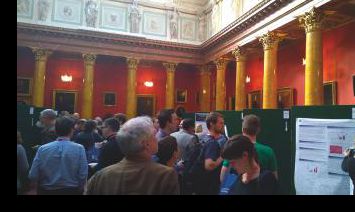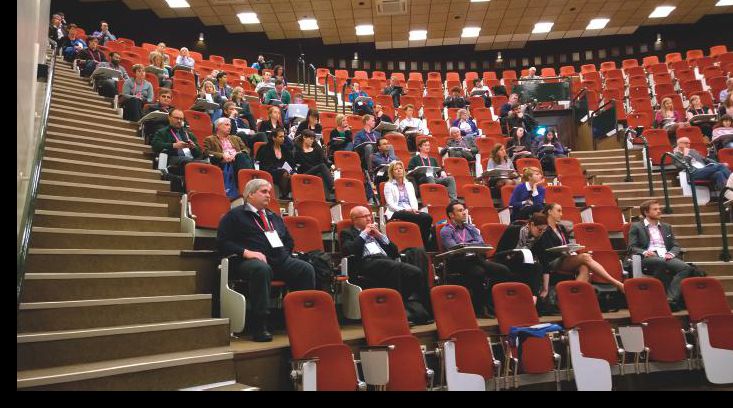
Physiology News Magazine
Ageing and Degeneration: a Physiological Perspective
Events
Ageing and Degeneration: a Physiological Perspective
Events
Roger Thomas
Editor, Physiology News
https://doi.org/10.36866/pn.99.13
10–11 April 2015,
Royal College of Physicians, Edinburgh, UK
This, the second of the Society’s Topic Meetings, dominated by a symposium, took place in the opulent premises of the Royal College of Physicians of Edinburgh, who were obviously extremely prosperous in the 19th Century. More recently they had built a splendid 300-seat lecture theatre, with spacious seats and excellent audio-visual system. The symposium organisers were Marc Poulin (Calgary), Simon Gandevia (Sydney), Ylva Hellsten (Copenhagen), Paul Greenhaff (Nottingham) Brian Head (San Diego), Mandy Jackson (Edinburgh) and Ian Forsythe (Leicester).
The first session was introduced by the meetings secretary, Ken O’Halloran. It began with the plenary lecture: 45 minutes on Healthy Cognitive Aging, given by Ian Deary of the University of Edinburgh. He compared the results of cognitive tests of virtually all 11-year olds born in 1921 and 1936 in Scotland with tests of some of the same individuals as adults many decades later. Of course almost all properties tested declined with age, but it was remarkable how high scores at age 11 often corresponded with good results in 70-90 year olds.
After coffee in the impressive Great Hall, where some 40 posters were displayed, there were talks covering aspects of ageing, exercise and brain health. Kirk Erickson from Pittsburgh reported that brain scans showed that in the elderly moderate exercise, but not simple stretching, increased the size of the hippocampus and frontal cortex. He concluded that physical activity is beneficial for learning, memory and brain health for people of all ages. The audience clapped, but otherwise hardly moved a muscle till lunchtime.
Lunch was served in the space below and behind the lecture theatre, while coffee or tea was available in the Great Hall, with the posters. Two of these had my initials as an unexplained acronym. Enquiries of other viewers led me to understand that RCT means Randomly Controlled Trials, or something similar. I quote the first part of the first sentence of the abstract of poster 21, from Oxford, ‘Evidence from experimental RCTs of regular exercise programs in previously sedentary adults….’. The main conclusion seemed to be that the relationship between aerobic fitness and cognitive performance remains equivocal.
The first session on Friday afternoon was about falling in the aged, with two talks from Australia, two from the USA, and one from the Netherlands. The main take-home message again was that all exercise is good, while falling is bad. I did learn a new word from the last talk before tea: ‘assortativity’. According to Wikipedia it means a preference for a network’s nodes to attach to others that are similar in some way. Sadly I am no wiser, but the talk by Arthur Kramer of Illinois in which it appeared was about cross-sectional and intervention studies of fitness differences and fitness training.
After tea the talks covered skeletal muscle oxygen supply in ageing. Apparently with age red blood cells are less able to release ATP, and the arteriolar response to acetylcholine is reduced. Briefly, everything deteriorates with age, but training regimes can offset some responses. After these five talks and an attempt to take a group photograph on the stairs up to the Great Hall, drinks were served in the magnificent library.
On Saturday the first session covered ageing, physical activity and neurodegeneration. Mitochondrial DNA deletions were implicated in neuromuscular degeneration, but the aging brain is still surprisingly adaptable, as shown during recovery after strokes. After coffee there were five talks featuring membrane biology and function, with membrane lipid rafts playing a key role. Such rafts in nerve cell membranes establish cell polarity by clustering pro-growth receptors and tethering cytoskeletal machinery. They require a scaffold protein called caveolin. Remarkably, Brian Head of San Diego showed that overexpression of caveolin had multiple effects on mice dendritic arborization and even prolonged the lifespan of the nematode C. elegans. The last session of the symposium covered cerebellar ataxia and neurodegeneration. This was followed by a final poster session. The Society Dinner was held in the Scotsman Hotel, with drinks for an hour, before dinner was tardily served at 20.15 in a low-ceilinged basement room. The meetings secretary made a brief speech thanking all concerned, and guests departed into a howling cold wind. Total attendance at the meeting was about 150 people, with 60 attending the dinner.
I left determined to take more exercise while I still remember how good it is for almost all physiological properties.



